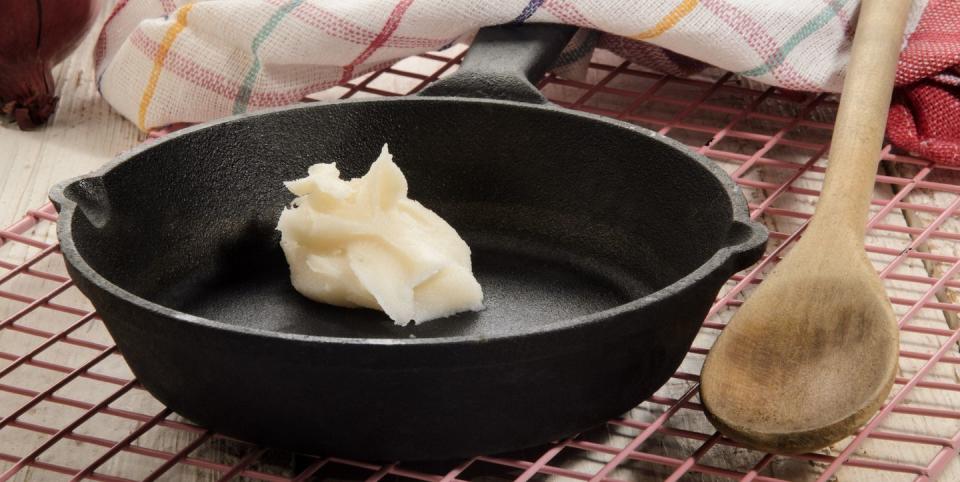More Folks Are Rediscovering Cooking with Lard. Here's How to Use It—and Where to Find It

“Hearst Magazines and Verizon Media may earn commission or revenue on some items through the links below.”
If you're trying out a recipe for classic buttermilk fried chicken, looking to make a truly flaky pie crust, or trying to perfect your biscuit game, you may have stumbled across an ingredient list that calls for lard.
The once-ubiquitous, then ridiculed, then long out-of-fashion cooking ingredient has been making a resurgence thanks to a new generation of cooks who are interested in reviving formerly forgotten cuts of meat (and other animal parts).
What is lard?
Lard is a cooking fat, much like olive oil, coconut oil, or vegetable shortening, that comes from rendered pork fat. Lard is typically solid at room temperature, even more so than butter—and in fact some culinary traditions treat it more or less like butter. However, if you're expecting it to taste like bacon drippings, you might be surprised. Like the best neutral cooking oils, pure leaf lard has hardly any flavor.
If you're interested in adding the lard to your recipe regimen, here's how to use it, where to find it, and easy ways to either substitute, or make your own.
What can I use lard for?
Traditionally, lard has stepped in for things like butter or oil when it comes to cooking and deep-frying (or actually those oils have come to replace lard, which was used in older recipes).
Lard is useful for both frying and baking. Its particular chemical makeup makes it ideal for making super crispy, not-greasy fried foods like seafood or fish. It's also great for achieving more perfectly flaky pie crusts. And if you're feeling daring enough, you can even spread it onto toast as you would butter.
Is lard a healthy fat?
Because of its high cholesterol content, there are definitely some health concerns about using too much of it. But everything in moderation! According to NPR's The Salt, lard is healthier than hydrogenated vegetable oils like shortening, but it's not as healthy as, say, olive oil.
There's no denying the fact that lard is a fat. And like all fats, it is incredibly calorie-dense. Lard is also a source of cholesterol. But as far as fats go, it's far from the worst. Lard boasts 20 percent less saturated fat than butter and a higher concentration of "healthy" monounsaturated fats, according to The Guardian. Pure lard also doesn't contain any trans fats—the thing the World Health Organization is working to eliminate (though you have to be careful what kind you buy—see below). Ultimately, as with anything, moderation is key.
Where do I find lard in the grocery store?
Not every supermarket carries lard, so it may be best to call ahead before driving around in search of it. However, if your local supermarket does carry it, you're most likely to find in in tubs in the meat section, or near the cooking oils, or in the international or Mexican foods aisle (where it is likely labeled in Spanish: manteca).
If you find sold on an unrefrigerated shelf it may have undergone a hydrogenation process. This gives it a longer shelf life, but it will then include some trans-fats. It will also have less vitamin D. If you are having trouble tracking it down, you can always find it online.
Can I buy lard from a butcher?
Yes—and it's much more likely that the lard you purchase there has not been hydrogenated. You can also ask your local butcher for a piece of back fat to take home and render on your own. It's easier than you think. You simply simply dice the fat, melt it in a slow cooker for a few hours, strain it, and store it in the fridge.
Where else can I buy lard?
Head to your local farmers' market or go straight to the source—a farmer who raises his or her own pigs. You can also order online from certain farms, ranches, or butchers, including Fannie and Flo and Grassland Beef.
What if I can't find lard?
If you need to make that recipe soon and can't wait for a delivery from Amazon, or you're still not fully sold on lard and would rather use something a little more familiar, you can simply stick with a cooking oil that you're more familiar with. For deep frying, use a high-heat oil like peanut or canola. For baking and pastries, use butter or shortening.
You Might Also Like

 Yahoo Movies
Yahoo Movies 